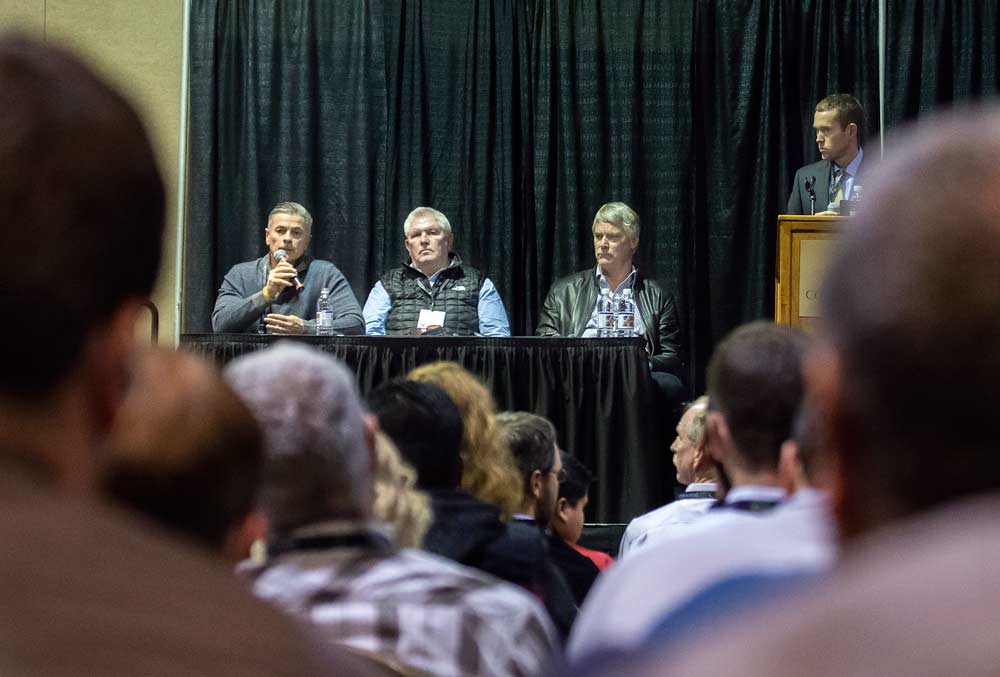
Michael Butler, left, chairman and CEO of Cascadia Capital, discusses the changing economics of the tree fruit industry from the perspective of investors at the Washington State Tree Fruit Association Annual Meeting in Kennewick in December. With him on the panel are Dennis Jones of Jones Farms in Granger, center, and Rick Plath of Washington Fruit and Produce in Yakima. Dan Plath, Washington Fruit and Produce moderated the panel. (TJ Mullinax/Good Fruit Grower)
The tree fruit industry is at an “inflection point.” Orchards are underfunded, packing facilities are underused and the fruit industry is ready for outside investors.
So said Michael Butler, chairman and CEO of Cascadia Capital, in December at the Washington State Tree Fruit Association’s Annual Meeting in Kennewick.
This all could be good in the long run, leading to higher returns on average, but the industry may go through some painful consolidations in the short term to get there, he said.
“We see an industry that is going to consolidate, and assets will end up in the hands of the best, most well capitalized operators,” Butler said.
Butler co-founded Cascadia Capital, a Seattle investment firm that works in many arenas. Butler specializes in agriculture. He was one of three speakers during a panel discussion about a wide array of industry trends and market changes with Dennis Jones, a Granger, Washington, organic grower, and Rick Plath, president of Washington Fruit and Produce, one of Washington’s largest fruit packing companies.
Some of the most exciting developments in the industry are trees from tissue culture labs, said Plath. They require much less lead time than traditional orchard stock and have low mortality rates. However, Plath does not suspect they will speed up the overall pace of new plantings.
“It allows you to make a decision a little bit later or if you’re forgetful like some of us, it kind of covers your mistakes up,” he said.
For Jones, an independent grower, the most exciting developments have been the surging demand for organic fruits and his investment in Enza club varieties. “It allows us as small orchardists to have high-value crops.”
Butler, however, stuck to the financial side of the tree fruit industry, predicting it will likely go through some consolidation.
Packing houses are running below capacity, sometimes 30 percent below. Those companies are looking for more acreage to boost returns and pay the debt on those expensive new lines with optical sorters. On the other hand, orchardists lack the money to invest in new varieties and high-density orchards at a pace to feed those lines, he said. Meanwhile, retailers like Kroger and Trader Joe’s are turning into powerful buyers and tough price negotiators.
On the other side of the coin, he foresees many smaller growers surviving and thriving as niche growers through direct marketing.
The folks in the middle — too big for niche production but too small to vertically integrate — will feel the squeeze. “Folks that aren’t vertically integrated are vulnerable,” he said. So are “subscale” growers, perhaps those with 700 to 1,000 acres or less.
“It’s painful to go through, but what we see on the other end is a better, more profitable, better capitalized industry,” he said.
Meanwhile, the industry is ripe for outside investment, money from beyond the owning families, he said.
Equity capital investors are the most likely to enter the fruit industry, he said, especially family office and pension fund capital. Both types of money are backed by patient investors, comfortable with remaining passive, minority owners for decades. In contrast, private capital backers usually want to be active and own a majority share and are less attracted to the fruit industry, he said.
Venture capital is showing up in the technology area of tree fruit, most notably in robotic harvesting, he said.
Earlier this year, one of the front-runners of the technology, Abundant Robotics of Hayward, California, announced a funding package of $10 million to help them make their vacuum picker ready for commercial harvests. Butler foresees different business models bringing that technology to growers. Perhaps investors will own the harvesters and lease them to the growers, he said.
Elsewhere in the conference, economic speakers forecast price compression as the apple crop volumes soar, perhaps to hit 170 million boxes within five years.
Apple orchard profits before taxes have been rising for the past 15 years or so, but that will likely flatten, said Michael Swanson, an economist for Wells Fargo, the nation’s largest agricultural lender. It won’t reach 20 percent. “Few industries do,” said Swanson, the meeting’s keynote speaker.
Washington’s crop volumes will continue to rise, possibly exceeding 170 million boxes in the next five years, said Dennis Bigness of Northwest Farm Credit Services. That will likely lead to price compression and an even tighter labor crunch.
“I didn’t want to be a downer, but it just is what it is,” he said with a laugh.
Both Swanson and Bigness anticipated lower margins for organic apples as the industry ramps up supply to keep up with demand, though they likely will remain profitable. •
– by Ross Courtney






Leave A Comment